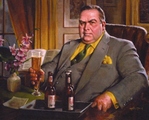 The second installment in Stout's Wolfe/Goodwin series is a great follow-up to Fer-de-Lance, following up the outlandish machinations of the killer in the first novel with s more subtle, psychological criminal. The main characters don't really develop (ever), but they are honed somewhat as Stout solidifies his vision for the series.
The second installment in Stout's Wolfe/Goodwin series is a great follow-up to Fer-de-Lance, following up the outlandish machinations of the killer in the first novel with s more subtle, psychological criminal. The main characters don't really develop (ever), but they are honed somewhat as Stout solidifies his vision for the series.
Wolfe is approached by a man carrying both a burden of fear and guilt--back in college, he was one of a group of students (associated only by place of residence) played a prank on an underclassman which resulted in a tragedy leaving the victim crippled. Years later, these students are mostly very successful in their various fields but are bound together by this incident, they have periodically helped their victim in various ways throughout the years until he has found his own measure of success. However, it now seems that he has also taken to exacting his revenge on those he holds responsible, and Wolfe's prospective client wants the detective to put an end to it. Wolfe sends him away, but is eventually provoked by circumstances, money and, of course, Archie to take up the case -- investigating a missing persons case, two deaths, and potentially preventing many others.
Stout's novels are filled with all sorts of characters--particularly when the clients are committees, as in this novel. Most of the characters (even, occasionally, the villains) are little more than a name and a near-stereotypical collection of behaviors/remarks. But most stories feature a character or two (beyond the regular cast of characters) that really stand out and are memorable. TLoFM features two of these: Paul and Dora Chapin. Paul Chapin is an author of some talent, who was left crippled (physically) after the prank mentioned above, but he seems to have been born with an emotional/psychiatric disability that's worse than that--the physical injury just makes him even more demented. Contemporary authors might do more with his character, might explore the depths of his depravity more than Stout did, but they wouldn't do so as effectively. (incidentally, he has to be played by Michael Emerson if they were ever to film this). I really can't describe his wife without getting into spoiler territory, but the pair are amongst the most memorable of all Stout's creations.
This is closer to the fully-formed Wolfe novel than Fer-de-Lance, but it's not all the way there yet. For example, Inspector Cramer was smoking a pipe, not chewing a cigar; the chairs used in the office for the guests are non-descript (now that I'm looking for its first appearance, I'm really missing the red leather chair); and Wolfe uses a top-of-the-line atlas instead of his giant globe to take his fantasy trips away from a complicated case. But we are introduced to what will be mainstays of the series: large crowds assembled in Wolfe's office a time or two; his very dramatic revealing of the solution to the case; and best of all, the introduction of Wolfe's rival, foil, colleague, champion, and almost friend--Inspector Lionel Cramer of Homicide.
As with any Stout, there are a few handfuls of lines that deserve quoting and requoting, I really should've kept a notebook or something handy to jot them down. As it was, I only got three of them noted:
...with the quarry within reach, the purpose fixed, and the weapon in hand, it will often require up to eight or ten minutes to kill a fly, whereas the average murder, I would guess, consumes ten or fifteen seconds at the outside. - NW
She was following what Wolfe called the Anglo-Saxon theory of the treatment of emotions and desserts: freeze them and hide them in your belly. - AG
I felt uncertain too, when I saw her. They don't come any uglier...At that she wasn't really ugly, I mean she wasn't hideous. Wolfe said it right the next day: it was more subtle than plain ugliness, to look at her made you despair of ever seeing a pretty woman again. - AG




0 comments:
Post a Comment